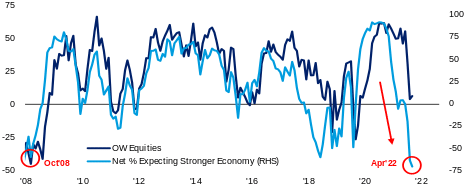By Vicki Schmelzer
NEW YORK (MaceNews) – Global recession became the top “tail risk” for world investors in April, according to BofA Global Research’s monthly fund manager survey, released Tuesday.
Recession concerns overshadowed other fears including “hawkish central banks” and “Russia-Ukraine conflict” and clouded the investment outlook, the survey said.
In April, a net 71% of fund managers looked for weaker economic growth in the coming 12 months, “the lowest growth expectations ever (back to ’95),” the survey said. This compared to a net 64% in March which at the time was the worst outlook since July 2008.
In addition, a net 66% of managers voiced concern about “stagflation,” that is below-trend growth and above-trend inflation, the highest reading since August 2008 and up from a net 62% in March.
Indeed, even as inflation concerns moderated, commodity allocation stood at a new record high.
A net 40% of fund managers looked for lower global CPI in the coming 12 months, compared to a net 5% in March and a net 56% in February, which was the lowest inflation expectation since January 2009.
Expected central bank tightening led to reallocation out of bonds into global equities and commodities.
In April, a net 68% of managers were underweight bonds, compared to a net 56% underweight in March and a net 72% underweight in February.
A net 6% of portfolio managers were overweight global equities in April, compared to a net 4% overweight in March and a net 31% in February.
Global investor allocation to commodities rose to a record net 38% overweight in April, compared to a net 33% overweight in March and a net 31% overweight in February and January.
Average cash balances stood at 5.5% in April, compared to 5.9% in March and 5.3% in February. As in March, this month’s reading again “triggers FMS Cash Rule tactical ‘Buy’ signal,” which would suggest U.S. equity returns of +1.3%, +4.0% and +6.5% on a one-month, three-month, six-month basis respectively, BoA Global noted.
Allocation to cash rose to a net 47% overweight this month, compared to a net 46% overweight in March and a net 38% overweight in February.
In terms of the U.S. Federal Reserve raising interest rates, global investors on average now expect 7.4 Fed rate hikes in 2022, compared to views for 4.4 Fed rate hikes in March and three Fed rate hikes in January.
On regional equity asset allocation, global investors made only modest changes.
Allocation to U.S. stocks rose to a net 14% overweight in April, compared to a net 12% overweight in March and a net 15% underweight in February.
Investors saw the so-called “Fed-put” for the S&P 500 at 3,637, or 17.6% below Monday’s S&P 500 close of 4,412.53. Under this “Fed-put” notion, the Federal Reserve would purportedly take policy easing action to prevent further stock losses if this downside support was broken. The “Fed-put” was seen at 3,636 in March and 3,698 in February.
“A majority of investors (64%) expect the S&P 500 to break through the 4000 level first before breaking through the 5000 level (26%),” BofA Global said.
This month, a net 17% of managers were underweight eurozone stocks, compared to a net 18% underweight in March and a net 30% underweight in February.
Fund managers had a net 3% underweight exposure to global emerging markets (GEM) in April, compared to a net 1% overweight in March and a net 11% overweight in February.
Allocation to Japanese equities stood at a net 2% underweight this month versus a net a net 8% underweight in March, while UK equity allocation stood at a net 7% underweight compared to a net 13% underweight in March.
In April, fund managers were again asked to rate the top potential risks to financial market stability. A net 92% of those polled said “Geopolitical Risk,” a net 83% said “Monetary Risk” and a net 71% said “Business Cycle Risk.”
Last month, a net 95% of those polled said “Geopolitical Risk,” a net 81% said “Monetary Risk” and a net 61% said “Business Cycle Risk.”
In April, the biggest “tail risks” feared by portfolio managers were: “Global recession” (26% of those polled), “Hawkish central banks” (25%), “Inflation” (21%), “Russia-Ukraine conflict” (16%), “Asset bubbles pop” (7%) and “COVID-19” (1%).
In March, the biggest “tail risks” were: “Russia-Ukraine conflict (44% of those polled), “Global recession” (21%), “Inflation” (18%), “Hawkish central bank rate hikes” (9%), “Asset bubbles” (5%), “COVID-19” (4%) and “China credit event” (1%).
This month, the “most crowded” trades deemed by global managers were: “Long Oil/Commodities” (34% of those polled), “Short U.S. Treasuries” (18%), “Long Tech Stocks” (16%), “Long ESG” (11%), Short China” (8%) and “Long Bitcoin” (7%).
In March, the “most crowded” trades were: “Long Oil/Commodities” (42% of those polled), “Long Tech Stocks” (17%), “Long ESG” (12%), “Short U.S. Treasuries (7%) and “Long Bitcoin” (7%).
An overall total of 329 panelists, with $929 billion in assets under management, participated in the BofA Global Research fund manager survey, taken April 1 to 7, 2022. “292 participants with $833bn AUM responded to the Global FMS questions and 153 participants with $311bn AUM responded to the Regional FMS questions,” BofA Global said.
Contact this reporter: vicki@macenews.com
Stories may appear first on the Mace News premium service.
For real-time email delivery contact tony@macenews.com.
Twitter headlines @macenewsmacro

